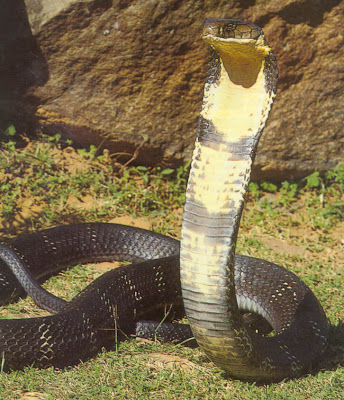 The Indian Cobra is known around the world as highly venomous snake that feeds on rodents, lizards, and frogs. As well as biting, the Indian cobra can attack or defend itself from a distance by "spitting" venom, which, if it enters the opponent's eyes, causes severe pain and damage.
The Indian Cobra is known around the world as highly venomous snake that feeds on rodents, lizards, and frogs. As well as biting, the Indian cobra can attack or defend itself from a distance by "spitting" venom, which, if it enters the opponent's eyes, causes severe pain and damage.Behaviour of Indian Cobra
When threatened, the Indian Cobra will assume its characteristic posture. It will raise the front one-third of its body and elongate its long, flexible neck ribs and loose skin to form its distinctive hood, on which are resembled eyes. .
Status of Cobra in India
Although the Indian Cobra is not an endangered species, it has recently been hunted for its distinctive hood markings in the production of handbags. It is listed under the treaty because it closely resembles other species that are threatened and in need of protection.
Physical Characteristics of Indian Cobra
The Indian Cobra's most known characteristic features are the wide black band on the underside of the neck, and the hood marking design which shows half-rings on either side of the hood. It is a smooth-scaled snake with black eyes, a wide neck and head, and a medium-sized body. Its colouring varies from black, to dark brown, to a creamy white. The body is usually covered with a spectacled white or yellow pattern, which sometimes forms ragged bands. The Indian cobra may grow from 1.8m to 2.2m.
Those Cobras which have the single ring on the hood are found in Assam and Eastern India and spit venom like the Ringhals Cobra of South Africa which can eject a spray for a distance of more than two meters and cause severe eye pain, sometimes blindness. Keepers who attend this particular variety of Cobra sensibly wear goggles.
Indian King Cobra







